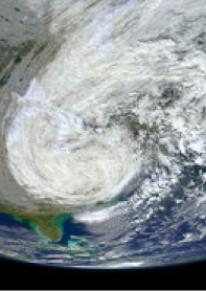By David Watts, Executive Adjuster, McLarens
Like double decker buses, Bermuda hadn’t had a hurricane make landfall for 27 years – then experienced two in five days. The phenomenon tested loss adjusters at McLarens to the limit.
The odds on the same location being hit by two hurricanes within five days are millions to one, but that is exactly what happened to Bermuda in October 2014 when Hurricanes Fay and Gonzalo struck on the 12th and 17th of that month respectively. Fay was predicted to be a relatively minor tropical storm, but it intensified into a Category One hurricane when making landfall on Bermuda. This was the first hurricane to make landfall on Bermuda since Hurricane Emily in 1987. It was also only the fifth hurricane of the 2014 Atlantic hurricane season, which had otherwise been benign. Despite its modest strength, Fay produced relatively extensive damage on Bermuda with clear evidence of tornados being present within the storm system. Several roads, including Front Street – the country’s main street – were flooded, and many boats, some up to 18 metres in length, broke their moorings and were damaged or destroyed. Domestic and commercial properties were also damaged throughout the various parishes that make up Bermuda. Gonzalo was a different animal. Having dealt with a major loss incident on Bermuda in 2013 and immediately fallen in love with its people and culture, I had kept a close watch on the weather patterns during the 2014 hurricane season – as any good loss adjuster would. The local newspaper had formally announced that they had escaped this season, so I thought that was that. McLarens has a well-established relationship with Freisenbruch Meyer Group, one of the main insurance providers on Bermuda. We are committed to sending a team of adjusters in the event, or even threat, of a hurricane. Lessons had been learnt following Hurricane Fabian in 2003 when the causeway that separates the airport from the island was washed away, preventing access for anyone who may have wished to fly in after the event. We were placed on notice the day after Fay – but 24 hours later we were told, “Please get here now!”. The reason was that every model being produced by the National Hurricane Centre was predicting a direct hit by a much bigger hurricane that would arrive in days. Given my previous experience – and availability – I flew out the following day, arriving on 15 October. The difficulty in the early stages – and in fact throughout – such an event is to gauge the manpower requirement, but at that point we decided on just one additional body and I was then joined by a colleague, Tim McGee, who arrived the following day.
Getting ready for Gonzalo
The day before Hurricane Gonzalo was electric, with several meetings to agree on strategy following the event. There is no car hire on Bermuda and the only real way to get around is by scooter. As I arrived at the hire shop there was a queue of tourists urgently returning bikes, but only one person was collecting one. The day of Gonzalo was somewhat surreal and one for the bucket list. The normally bustling Hamilton was deserted – even though the storm was not due to hit for another 10 hours – as everyone had left to secure their properties in preparation. Predictably, as the hurricane approached, the winds intensified, culminating in relentless horizontal rain and incredible wind strengths. Then, just like in the movies, everything suddenly calmed as the eye passed over. We even saw locals quickly walking their dogs! The eye during Gonzalo took virtually a full hour to pass, demonstrating the size of the storm and then, without warning, we were slammed in the opposite direction, with the winds even more destructive. The majority of those outside Hamilton had no power for days or even weeks after the storm. Hurricane Gonzalo was the first Category Four major hurricane in the Atlantic since 2011. It peaked with maximum winds of 145mph, but fortunately weakened to a Category Two as it passed over Bermuda. That said, the following morning it was clear that the damage was going to be significant.
Planning to be proud of
Despite being over 10 years since the last major hit during Fabian, the disaster planning of our new principals was outstanding. They had managed to visit every Hurricane Fay claim in the four-day lull and had photographed and documented the damage. Many properties were damaged in both storms and it would have proven a difficult or impossible task to evaluate the damage in each storm had they not completed this exercise. Bermuda’s infrastructure is sound and locations are accessible either by road or boat. While it appears to be one continuous landmass it is actually made up of 181 islands, and several claims we handled involved private residences – including those of some notable celebrities – on a specific Island, which sometimes had Value-at-Risk and increased repair cost implications. The availability of roof slate proved a particular problem as the majority of properties affected had this form of roof covering which, unlike the UK, comprises a limestone material. There were insufficient stockpiles and the quarries initially rationed the amount they would allow to each contractor, before going into roofing themselves. Having taken stock of the situation, the team was ramped up to in order to meet the workload requirements and on average we had four adjusters on the ground for the next few months. There is strong competition for business between the four main insurers and it was critical to keep ahead of the competition. Team selection in such a prestigious fixture is not as simple as you would think. Not only must you be able to commit for several months, you need to be able to fully embrace the social aspects of Bermuda, which is a skill in itself. Our team consisted of Tim and myself, Mike Clementson, Neil Stephens, Pat Dunworth and Douglas McDougal. It took four months to complete the tour, working on average10 hours per day with the odd Sunday off. We helped settle or progress over 500 property claims. We would never wish ill of such a beautiful island and people, but you may rest assured that a certain team of adjusters will be closely watching the next hurricane season.
This article originally appeared in Post Magazine on 13 April 2015.





